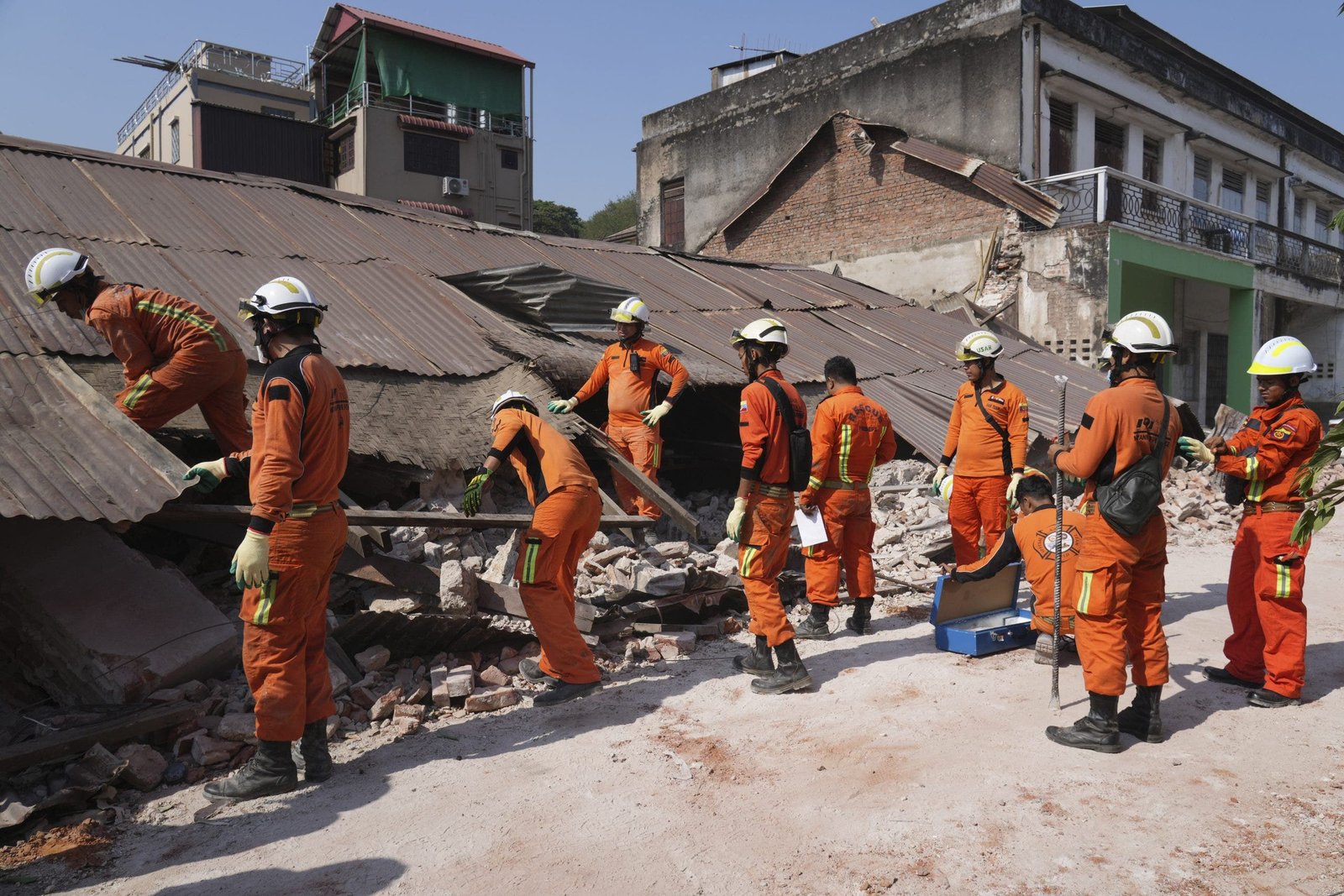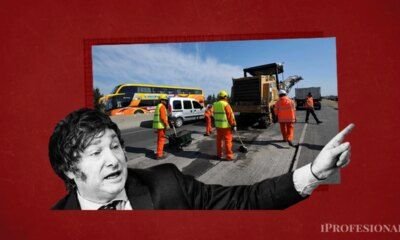INTERNACIONAL
Survivors still being found from Burma earthquake, but hopes begin to fade as deaths exceed 2,700

- A 7.7 magnitude earthquake rocked Burma on Friday, killing more than 2,700 people, compounding a humanitarian crisis caused by a civil war.
- The death toll is expected to rise, but the earthquake hit a wide swath of the country, leaving many areas without power, telephone or cell connections and damaging roads and bridges, leaving the full extent of the devastation hard to assess.
- The World Health Organization said more than 10,000 buildings are known to have collapsed or been severely damaged in Burma. The earthquake also hit neighboring Thailand, causing a high-rise building under construction to collapse and burying many workers.
Rescue workers saved a 63-year-old woman from the rubble of a building in Burma’s capital on Tuesday, but hope was fading of finding many more survivors of the violent earthquake that killed more than 2,700 people, compounding a humanitarian crisis caused by a civil war.
The fire department in Naypyitaw said the woman was successfully pulled from the rubble 91 hours after being buried when the building collapsed in the 7.7 magnitude earthquake that hit midday Friday. Experts say the likelihood of finding survivors drops dramatically after 72 hours.
Death toll numbers forecast to increase
The head of Burma’s military government, Senior Gen. Min Aung Hlaing, told a forum in Naypyitaw, that 2,719 people have now been found dead, with 4,521 others injured and 441 missing, Myanmar’s Western News online portal reported.
BURMA-THAILAND EARTHQUAKE: PATRICK SCHWARZENEGGER, ‘WHITE LOTUS’ CAST SEND PRAYERS AS DEATH TOLL PASSES 1,000
Those figures are widely expected to rise, but the earthquake hit a wide swath of the country, leaving many areas without power, telephone or cell connections and damaging roads and bridges, leaving the full extent of the devastation hard to assess.
Most of the reports so far have come from Mandalay, Burma’s second-largest city, which was near the epicenter of the earthquake, and Naypyitaw.
«The needs are massive, and they are rising by the hour,» said Julia Rees, UNICEF’s deputy representative for Burma.
Burma’s rescuers work through rubble of a collapsed building following Friday’s earthquake in Naypyitaw, Burma, on April 1, 2025. (AP Photo)
«The window for lifesaving response is closing. Across the affected areas, families are facing acute shortages of clean water, food, and medical supplies.»
Burma’s fire department said that 403 people have been rescued in Mandalay and 259 bodies have been found so far. In one incident alone, 50 Buddhist monks who were taking a religious exam in a monastery were killed when the building collapsed and 150 more are thought to be buried in the rubble.
Structural damage is extensive
The World Health Organization said that more than 10,000 buildings overall are known to have collapsed or been severely damaged in central and northwest Burma.
The earthquake also rocked neighboring Thailand, causing a high-rise building under construction to collapse and burying many workers.
Two bodies were pulled from the rubble on Monday and another was recovered Tuesday, but dozens were still missing. Overall, there were 21 people killed and 34 injured in Bangkok, primarily at the construction site.
In Burma, search and rescue efforts across the affected area paused briefly at midday on Tuesday as people stood for a minute in silent tribute to the dead.
MASSIVE 7.7 MAGNITUDE EARTHQUAKE ROCKS THAILAND, BURMA, COLLAPSING BUILDINGS AND KILLING MORE THAN 1,000
Relief efforts moving at a sluggish pace
Foreign aid workers have been arriving slowly to help in the rescue efforts, but progress was still slow with a lack of heavy machinery in many places.
In one site in Naypyitaw on Tuesday, workers formed a human chain, passing chunks of brick and concrete out hand-by-hand from the ruins of a collapsed building.
The Burma military government’s official Global New Light of Burma reported Tuesday that a team of Chinese rescuers saved four people the day before from the ruins of the Sky Villa, a large apartment complex that collapsed during the quake. They included a 5-year-old and a pregnant woman who had been trapped for more than 60 hours.
The same publication also reported two teenagers were able to crawl out of the rubble of the same building to where rescue crews were working, using their cellphone flashlights to help guide them. The rescue workers were then able to use details from what they told them to locate their grandmother and sibling.
International rescue teams from several countries are on the scene, including from Russia, China, India, the United Arab Emirates and several Southeast Asian countries. The U.S. Embassy said an American team had been sent but hadn’t yet arrived.
Aid pledges pouring in as officials warn of disease outbreak risk
Meantime, multiple countries have pledged millions in aid to assist Burma and humanitarian aid organizations with the monumental task ahead.
Even before the earthquake, more than 3 million people had been displaced from their homes by Burma’s brutal civil war, and nearly 20 million were in need, according to the U.N.
Many were already lacking in basic medical care and standard vaccinations, and the destruction of water and sanitation infrastructure by the earthquake raises the risk of disease outbreaks, warned the U.N.’s Office for the Coordination of Humanitarian Affairs.
«The displacement of thousands into overcrowded shelters, coupled with the destruction of water and sanitation infrastructure, has significantly heightened the risk of communicable disease outbreaks,» OCHA said in its latest report.
«Vulnerability to respiratory infections, skin diseases, vector-borne illnesses such as dengue fever, and vaccine-preventable diseases like measles is escalating,» it added.
The onset of monsoon season also a worry
Shelter is also a major problem, especially with the monsoon season looming.
Since the earthquake, many people have been sleeping outside, either because homes were destroyed or out of fear of aftershocks.
Civil war complicates disaster relief
Burma’s military seized power in 2021 from the democratically elected government of Aung San Suu Kyi, sparking what has turned into significant armed resistance and a brutal civil war.
Government forces have lost control of much of Burma, and many places were dangerous or impossible for aid groups to reach even before the quake.
Military attacks and those from some anti-military groups have not stopped in the aftermath of the earthquake, though the shadow opposition National Unity Government has called a unilateral ceasefire for its forces.
BURMESE GOVERNMENT DENIES CLAIMS IT KILLED 76 VILLAGERS
The NUG, established by elected lawmakers who were ousted in 2021, called for the international community to ensure humanitarian aid is delivered directly to the earthquake victims, urging «vigilance against any attempts by the military junta to divert or obstruct humanitarian assistance.»
«We are in a race against time to save lives,» the NUG said in a statement.
«Any obstruction to these efforts will have devastating consequences, not only due to the impact of the earthquake but also because of the junta’s continued brutality, which actively hinders the delivery of lifesaving assistance.»
It wasn’t immediately clear whether the military has been impeding humanitarian aid. In the past, it initially refused to allow in foreign rescue teams or many emergency supplies after Cyclone Nargis in 2008, which resulted in well more than 100,000 deaths. Even once it did allow foreign assistance, it was with severe restrictions.
CLICK HERE TO GET THE FOX NEWS APP
In this case, however, Min Aung Hlaing, pointedly said on the day of the earthquake that the country would accept outside help.
Tom Andrews, a monitor on rights in Burma commissioned by the U.N.-backed Human Rights Council, said on X that to facilitate aid, military attacks must stop.
«The focus in Burma must be on saving lives, not taking them,» he said.
INTERNACIONAL
Why Trump’s undeniable winning streak is drawing a barrage of negative coverage

NEWYou can now listen to Fox News articles!
Donald Trump has just had the best few weeks of his presidency.
No question. No argument. Period, end of paragraph.
It began with a bold gamble to send pilots to destroy Iran’s nuclear sites.
Then Trump managed to broker a cease-fire between Israel and Iran.
TRUMP’S ACHIEVEMENTS EMBOLDEN HIM TO BE EVEN MORE AGGRESSIVE
Meanwhile, as Trump delayed his sky-high tariffs, the stock market hit record highs.
And he won a $16-million settlement from CBS’s parent company in his lawsuit against unfair editing by «60 Minutes.» That means he has now beaten two of the three broadcast networks, having won the same sum from ABC in a suit involving a crucial mistake by George Stephanopoulos.
And after days of pressure and arm-twisting, he managed to pass the Big Beautiful Bill.
President Trump’s been on a serious winning streak these past few weeks – culminating in the passage of his «big, beautiful bill.» (Samuel Corum/Getty Images)
Make no mistake, the bill was always going to pass. What were Republicans going to say, never mind, we just tanked the president’s main legislative priority because we didn’t like this or that?
They didn’t need Democratic votes, under so-called reconciliation. And Trump controls the GOP. So its members fell into line.
Now the question is why, through this successful stretch, has Trump continued to draw such negative coverage?
TRUMP SIGNS ‘BIG, BEAUTIFUL’ BILL IN SWEEPING VICTORY FOR SECOND TERM AGENDA, OVERCOMING DEMS AND GOP REBELS
For starters, many in the media just can’t stand the guy. And this has largely been true since 2015. So anything that helps him must be wrong and must be denigrated.
Even the successful strike on Iran drew only scattered instances of grudging praise, when under any other president there would have been standing ovations.
The press immediately reframed this as a debate over whether the bunker-busting bombs had only set back Iran’s nuclear program by a few months.

The press’ scant praise over Trump’s Iran strikes quickly devolved into debate over how far they really set back Tehran’s nuclear program. (Planet Labs PBC via AP)
In fairness, that’s what the preliminary, classified Intel report leaked to the press said. And there’s nothing wrong with reporting that accurately, even though the assessment was made with low confidence.
But Trump wants reporters for CNN and the New York Times, which broke the story, fired over this, and with an FBI leak probe under way, says he may force journalists to reveal their confidential sources.
Once the White House could no longer blame anonymous sources, there is nothing wrong with quoting a government report – even if if turns out to be wrong.
The cease-fire between Israel and Iran was fine, but that quickly morphed into chatter about why Trump couldn’t pull off an end to the fighting between Israel and Hamas, a far more difficult task.
AFTER SETBACK TO IRAN’S NUCLEAR PROGRAM, TRUMP EXPECTED TO LEVERAGE MILITARY SUPPORT IN NETANYAHU MEETING
Not to mention his freezing of weapons shipments to Ukraine, when despite his «very disappointing» call with Vladimir Putin, who promptly unleashed the biggest drone and missile attack against Kyiv since the illegal invasion of its sovereign neighbor.
Perhaps the president is learning what has been obvious to the rest of us: Putin has no conceivable interest in peace.
Everyone had to report the stock market surge, though not with the enthusiasm of the earlier plunge, and Trump yesterday announced that he’d hit Japan and South Korea, two allies, with a 25 percent hike in tariffs. But they don’t take effect till Aug. 1, so this could just be another negotiating tactic.

There was also next to zero coverage of Trump’s $16 million settlement with Paramount. (Yuki Iwamura/Bloomberg via Getty Images)
There was almost no television coverage of Trump’s $16 million settlement with Paramount, which is nothing more than the news business protecting its own. If this had been any other kind of company – with the backstory that someone like Shari Redstone needed administration approval to sell the company and pocket $2 billion – the press would have gone haywire.
Now there’s a new twist. Fox’s Charlie Gasparino, writing for the New York Post, reported the Paramount settlement includes a side deal between Trump and for the buyer David Ellison, son of tech mogul Larry Ellison, for him to run $15 to $20 million in advertising supporting causes backed by the president.
And Trump confirmed it.
«We did a deal for about $16 million plus $16 million, or maybe more than that in advertising,» he told reporters.
Paramount denied any knowledge of the side deal.
SUBSCRIBE TO HOWIE’S MEDIA BUZZMETER PODCAST, A RIFF ON THE DAY’S HOTTEST STORIES
The president has also been drawn into a war of words with Elon Musk, calling him a «train wreck» who’s gone «off the rails» in forming a third party and raising the Epstein files again. Musk says the lack of an Epstein client list is the «final straw» – he had once apologized for raising it – and there’s no difference between the Republican and Democratic parties.
But there was one moment, in my view, that was a misstep by Trump.
The president had no need to negotiate with Democrats, who strongly opposed a tax cut tilted toward the wealthy while making deep cuts to Medicaid.
«Every Democrat in Congress voted against the ‘Big, Beautiful Bill…They wouldn’t vote only because they hate Trump, but I hate them, too, you know? I really do. I hate them. I cannot stand them, because I really believe they hate our country.»
CLICK HERE TO GET THE FOX NEWS APP
I don’t believe the overwhelming majority of Democrats hate their country. And that was hardly a unifying message on July 4 weekend. Maybe many in the media hate him and he was just counterpunching. But he didn’t need to go there.
On the other hand, Donald Trump has been getting terrible coverage since 2015, and he’s clearly grown tired of it.
INTERNACIONAL
París: nadar en el Sena, un sueño que esperó más de 100 años y que solo duró un día

Cerradas hasta nuevo aviso
Burlas en las redes
INTERNACIONAL
Qué se sabe de las inundaciones que arrasaron Texas y dejaron más de 100 muertos, incluidos decenas de niños

Varias inundaciones catastróficas asolaron el centro de Texas durante el fin de semana festivo del 4 de julio y han causado la muerte de al menos 104 personas, entre ellas 28 niños. Hasta el lunes por la noche, 10 campistas y un consejero se encontraban entre los desaparecidos.
En el condado de Kerr, el río Guadalupe creció 6 metros en dos horas el viernes, lo que obligó la evacuación de varios campamentos de verano.
Cientos de equipos de rescate seguían buscando supervivientes el lunes, mientras gran parte del centro de Texas, incluida la región de Hill Country, estaba bajo alerta de inundación.
Esto es lo que sabemos sobre las inundaciones:
Hasta el lunes por la noche, al menos 104 personas habían muerto en el diluvio catastrófico. La mayoría, 84, estaban en el condado de Kerr, una parte de Texas Hill Country al noroeste de San Antonio.

Más de dos decenas de los fallecidos eran menores, entre ellos varias niñas de tan solo 8 años que habían estado en el Campamento Mystic, un lugar de verano a orillas del río Guadalupe con más de 750 asistentes. Dick Eastland, director durante muchos años del Campamento Mystic, también murió tras ser arrastrado, según reportes, mientras intentaba rescatar a las niñas de la crecida de las aguas.
Los funcionarios del condado de Kerr dijeron el lunes que aún no habían podido identificar a los 22 adultos y 10 niñas que aparecieron muertos tras las inundaciones.
Los equipos de emergencia han rescatado a más de 850 personas utilizando helicópteros, caballos, barcos y camiones. A un nadador de rescate de la Guardia Costera se le atribuye haber salvado a 165 personas del Campamento Mystic.

Pero al menos 10 niñas del campamento seguían desaparecidas el lunes por la noche, junto con más de una decena de personas en toda la zona.
Las autoridades dijeron que comenzarían los esfuerzos de recuperación, incluida la limpieza de escombros y la reapertura de carreteras. El domingo, el presidente Trump emitió una declaración de desastre mayor que dirige la ayuda federal a la zona.
En principio, Trump tiene previsto viajar a Texas el viernes, dijo el lunes Karoline Leavitt, secretaria de prensa de la Casa Blanca. La Casa Blanca estaba coordinando con las autoridades locales la visita de Trump para evitar perturbar los esfuerzos de recuperación, dijo Leavitt.
A primera hora de la tarde del jueves, el Servicio Meteorológico Nacional emitió una alerta de inundación general para el centro-sur de Texas, incluido el condado de Kerr. Cuando los ríos de la región empezaron a crecer el viernes por la mañana debido a las fuertes lluvias, el organismo aumentó el nivel de sus advertencias.

La alerta más urgente, enviada poco después de las 4 a. m., advertía de una “situación especialmente peligrosa” e instaba a los residentes y campistas a buscar terrenos más elevados. En unos 90 minutos, el río Guadalupe se había desbordado de un metro hasta 10 metros, según un indicador fluvial cerca de la ciudad de Comfort, Texas.
El aguacero continuó durante el fin de semana, mientras los equipos de respuesta de emergencia buscaban sobrevivientes.
Las inundaciones son una amenaza histórica en el centro de Texas, una zona a la que a menudo se denomina el “callejón de las inundaciones repentinas”, y la cuenca del río Guadalupe en particular es una de las regiones más peligrosas para este tipo de fenómeno. El cambio climático también ha intensificado y aumentado la frecuencia del tiempo extremo.

Entonces, ¿por qué el Servicio Meteorológico no envió antes su alerta urgente? Algunos expertos afirman que la escasez de personal de la agencia puede haber dificultado la capacidad de los meteorólogos para coordinar las respuestas con las oficinas locales de gestión de emergencias.
El senador Chuck Schumer, el principal demócrata del Senado estadounidense, pidió el lunes al inspector general en funciones del Departamento de Comercio que investigara si los recortes y la escasez de personal del Servicio Meteorológico habían contribuido al elevado número de víctimas mortales en Texas.
Por otra parte, los funcionarios del condado de Kerr contemplaron en su día la posibilidad de instalar un sistema de alerta de inundaciones a lo largo del río Guadalupe, pero finalmente rechazaron la idea por considerarla demasiado cara. Por eso, cuando la catastrófica crecida de las aguas se produjo el fin de semana, no hubo sirenas ni monitores de inundación temprana. Las alertas de texto llegaron tarde para algunos residentes y otros las desestimaron o no las vieron.

Aunque las autoridades no han hecho pública la lista completa de víctimas, algunas de ellas han sido identificadas por sus familiares.
Entre las víctimas se encuentran Jeff Wilson, profesor de secundaria de los suburbios de Houston desde hace muchos años, que estaba acampado cerca del río Guadalupe con su esposa; Tanya Burwick, de 62 años, que conducía hacia su trabajo en San Angelo cuando su vehículo quedó atrapado por la crecida de las aguas; y Blair y Brooke Harber, dos jóvenes hermanas que se alojaban en una cabaña junto al Guadalupe cuando la caseta fue arrastrada por las aguas.
© The New York Times 2025.
climate,damage,natural disaster,storm,texas,weather
-
POLITICA2 días ago
Para La Libertad Avanza el acuerdo con PRO está encaminado, pero aún hay mutua desconfianza
-
ECONOMIA9 horas ago
Chau Vialidad: anticipan una pelea por la financiación de 9.000 kilómetros de rutas
-
POLITICA3 días ago
El Gobierno avanza con un plan que complica a los gobernadores y pone en riesgo sus alianzas en el Congreso























